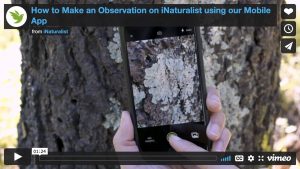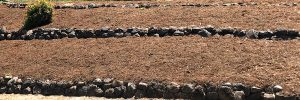![]() Ця сторінка також доступна українською.
Ця сторінка також доступна українською.
Introduction
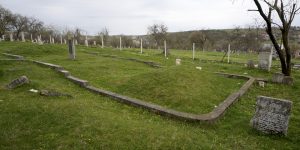
Groomed grass, concrete edging, mounded shapes, and a monument with text together inform visitors to the grounds of the Jewish cemetery and mass grave of Pidhaitsi (Ternopil oblast). Photo © RJH.
Regardless of their current condition, Jewish cemeteries in western Ukraine are historical cultural landscapes which integrate manmade and natural features. The memorial function of cemeteries is visually enhanced by the form and placement of the manmade features; prewar burial grounds which were stripped of headstones, walls, and other signifying markers during or after the war can benefit significantly from new installed monuments and landscaping. Jewish mass graves, intentionally obscured at their inception and subsequently avoided or ignored in discomfiture and shame, are often located in blank or even distressing landscapes; this presents a challenge to heritage activists who wish to remake the sites as places of respect for the victims buried there. Project leaders must keep in mind the historical purpose and appearance of the landscape, whether Jewish cemetery or mass grave. It is almost never possible to “restore” a burial site, only to adapt it to a renewed or new purpose.
Because landscape design and development for a Jewish burial site is “grounded” in the place, it is tightly interwoven with most other project types described on this website, including surveys, concepts, clearing and cleaning, memorial monuments, fences and walls, and signage, as well as the less tangible but equally important project aspects of sustainability planning, support and funding, and communication; landscaping should be considered when nearly all project types are in planning stages. As a key influence on site appearance and visitor response, the landscape links very closely to memorial monument design, and the two functions should work together.
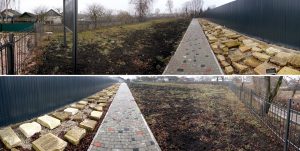
Two views from opposite ends of the residual fragment of the Jewish cemetery of Obertyn
(Ivano-Frankivsk oblast), showing hardscape and softscape elements of the design: lapidarium of headstone pieces, paved walkway, open space with grass covering, and perimeter fencing. Photos © RJH.
Although there are some examples of postwar memorial monuments at Jewish cemeteries and mass grave sites in western Ukraine, to date very few burial sites have benefited from intentional landscape design and development. Where past project efforts have altered the appearance of a site, in almost all cases the evocative and commemorative stimulus is a relatively small hardscape element, e.g. a monument or wall, but the much larger surrounding grounds themselves remain untouched and disengaged from the memory work. The few known regional examples of integral landscape development are illustrated on this page, but there are no realized landscaping projects among the case studies on this website yet, only plans. Examples of memorial site landscapes at non-Jewish sites around the world are included here to provide inspiration, and the references page on landscape planning and development provides links to many texts, articles, and videos on concepts, theory, and practice; a separate design tools page describes and links to paper and software approaches to creating and communicating design ideas and plans.
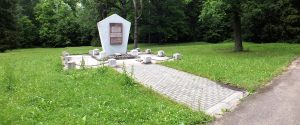
A landscaped memorial with monument at the Jewish mass grave in Ukmergė near Vilnius, Lithuania. Source: mikrimas.
Landscape design has both practical and aesthetic characteristics, either of which may be the compelling motivation to undertake the work; inevitably both are involved in the realized project, so it is usually wise to consider both even when one dominates. In the sections which follow, these characteristics are discussed along with process guidance and examples:
- surveying the existing landscape
- a brief outline of the landscape design process
- remedial landscaping and design for sustainability
- landscape design for reflection and commemoration
- additional examples of designed memorial site landscapes
Surveying the Existing Landscape
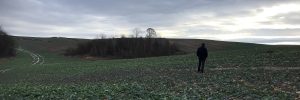
Landscape planning begins with a walking assessment, here at the Jewish cemetery of Krukenychi (Lviv oblast). Photo © RJH
Untended landscapes change quickly in western Ukraine. If a Jewish community burial site has not been recently evaluated and documented, any proposed landscaping project should start with a preliminary assessment of the site and if possible a more detailed survey. Essential elements of the assessment and/or survey in advance of landscape planning include:
- civil and religious community stakeholders
- burial site boundaries and 3D surface profile
- immovable hard features inventory and locations
- subsurface features inventory and locations
- environmental factors
- flora and fauna

A location survey of surviving headstones and fragments in the old Jewish cemetery of Rohatyn (Ivano-Frankivsk oblast). Photo © RJH.
Most of these survey elements are discussed in detail on the guide page for surveys on this website. Identifying and contacting stakeholders before firming project concepts can help engage partners and advocates to minimize misunderstandings with neighbors, officials, and local or national law. The site boundaries and ground surface profile become the “canvas” on which the future design will be defined, and help to scope the project and highlight potential risks and problems. Identifying and mapping hard features above and just beneath the burial site surface (walls, headstones, monuments, signs, utility poles and equipment, piping, etc.) is particularly important as constraints and opportunities for the landscaping plan. Assembling some form of an overall survey map is an important first step in the development of a landscape plan.
Focusing Some Survey Elements for the Landscape Plan
A few survey elements described on the guide page may need extra attention ahead of landscape design. For example, assessing and measuring the burial site surface topology should include an evaluation of water runoff, and it may be appropriate to specifically evaluate the soil quality and hydrology of the site. Landscape concepts which aim to enhance the aesthetics and commemorative function of the site will benefit from a study of the views into and out of the cemetery or mass grave space, and at least an informal assessment of nearby noise sources and their significance.
Assessing the Existing Flora and Fauna at the Site

Greater Celandine (Chelidonium majus) observed about 400m from the Jewish cemetery in Bibrka (Lviv oblast) by naturalist37049 and recorded on iNaturalist.
Surveying living organisms on and around the cemetery or mass grave is detailed here rather than on the general survey guide page because of the relationship between existing and planned vegetation in burial site landscape projects, and the need for ongoing management of landscape ecosystems including insects, birds, and other animals. Identifying and approximately counting plants, animals, and fungi normally covers not only beneficial or benign native organisms but also perceived pests and poisonous species as well as introduced or invasive species commonly found in open spaces in western Ukraine. Survey methods for plant, animal, and fungus species at Jewish burial sites are simple, typically conducted through walkover surveys, photography, and limited sampling for further research.
Probably because of the region’s long association with farming and land-related crafts, several useful resources for survey data and skills are the agricultural, forestry, and/or technical colleges and universities which are present in all of the oblasts of western Ukraine. For nearby support and local awareness, there are agricultural colleges not only in the oblast capitol cities but also in some medium-sized towns which may be closer to the burial site project location. Instructors and students at these educational institutions are knowledgeable in both domesticated/productive plants and animals but also wild organisms and pests, and importantly they can identify useful reference encyclopedias, databases, tools, and methods for identifying species and their characteristics as well.
A growing number of free and public internet resources are also available for identifying and studying plants, animals, and fungi found at Jewish cemeteries and mass grave sites and in their surrounding environments. The most helpful sites use crowdsourced observations and images, and some engage citizen scientists and experts who can assist with identifying species from photographs and geographic locations. Among the most useful internet resources are:
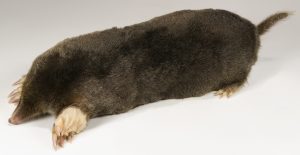
An image of the European Mole (Talpa europaea) seen in western Ukraine, from WikiSpecies.
WikiSpecies – A project of the Wikimedia Foundation, this species directory combines classification (taxonomy), images, naming sources, and references, plus (where available) links to more descriptive pages on Wikipedia and/or more images on WikiMedia Commons. WikiSpecies functions similarly to WikiData (and may be integrated with it in the future) but is structured specifically for living organisms. WikiSpecies allows searches in English and Ukrainian as well as many other languages, and species pages typically provide vernacular names in multiple languages as well. The project is in early development, with less than one million articles and only partial linking across languages.
iNaturalist – a project of the California Academy of Sciences and the National Geographic Society, this database builds on user submissions of species observations with data-driven analysis and provides crowdsourced identifications and other support, making it well-matched to species surveys. The tools are tailored to mobile devices for immediate use in the field, while mapping features and place-specific search tools can quickly identify observed species within a particular area. New “bio-blitz” projects can be organized to canvass areas (such as cemeteries); during one such project south of Berezhany (Ternopil oblast) in winter 2020-2021 a single surveyor observed, geotagged, and identified numerous species of lichen plus birds, field mice, and plants, and more than 75 users are active in the Ternopil region. The project is growing, with over 300,000 species identified to date through well over 50 million observations around the world.
Invasive Species Compendium – online database of global invasive species with highly detailed datasheets of information about dangers and controls; specialist contributors include researchers in Poland, Belarus, Hungary, Slovakia, and Russia

Just five of the many bird species observed and identified in and around the city of Nadvirna (Ivano-Frankivsk oblast) by dmutronadverniuk for iNaturalist.
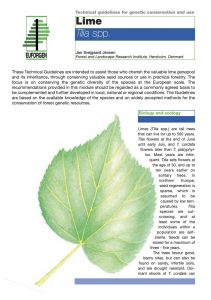
A detailed technical guide to conservation of the small-leaved linden tree (Tilia cordata) from the website of EUFORGEN. Click for the full details.
Other resources include:
World Flora Online – an internet-based Flora or plant index which gathers data from continent-scale and regional databases, aiming for comprehensive global coverage of plant data; includes names, descriptions, images, distributions, and references
Pan-European Species directories Infrastructure (PESI) – infrastructure for taxonomic standardization of species across Europe; partners have included the Ukraine State Museum of Natural History in Lviv
Euro+Med PlantBase – a database of plants across the Euro-Mediterranean region, evaluating plant diversity
Plants of the World Online – an online global plant database managed by the Royal Botanic Gardens at Kew; initially focused on tropical Africa but with an impressive searchable visual catalog covering Europe as well
Tela Botanica and eVeg – a French database of the plants of Europe, with more than 15,000 descriptive files
European and Mediterranean Plant Protection Organization (EPPO) – presents databases and guidance on plants and their pests, developed in cooperation with more than 50 member countries including Ukraine
European Forest Genetic Resources Programme (EUFORGEN) – a pan-European program to promote conservation of forest genetic diversity and sustainable management; includes guidance, publications, and a searchable descriptive catalog of more than 100 common European trees
An initial evaluation of the utility of these various resources for the survey of plants, animals, and fungi at Jewish burial sites is probably best done with species known to be widespread across western Ukraine, e.g. the ubiquitous small-leaved linden tree (Tilia cordata), the dangerous Sosnowsky’s hogweed (Heracleum sosnowskyi), and the common European mole (Talpa europaea).
Practice with mobile tools such as iNaturalist can quickly lead to proficiency, for a fast and efficient survey in one to several days of work, with follow-up to refine and confirm species identification. Many species appear seasonally, and others are migratory, so surveys are best conducted at least three times during the year. A small number of annoying or dangerous plants (nettle, hogweed, etc.) and animals (ticks, mosquitoes, moles, etc.) will be observed, but most resident and visiting species are benign or beneficial to the long-term health of the landscape, and some will contribute to the aesthetics of the site as well. Domestic animals (dogs, cats, chickens, goats, cows, horses, etc.) will frequently be observed as well and should be recorded in the survey, with the location of their permanent home if that can be determined. Study and experience will enable activists and volunteers to differentiate similar-looking species, especially important with potentially poisonous plants and animals.
A Brief Outline of the Landscape Design Process
Texts and articles on landscape design such as those summarized and linked on the references page highlight common approaches to the task, but also emphasize that creating a landscape plan is a process of evolution of concepts and details, that there is rarely only one “correct” design, and that successful designers may favor an artistic approach or a scientific one, or some blend of the two approaches.
Sometimes a project may begin with a concept, even before the landscape designer has visited the site; this can serve as inspiration and as reference for initial site assessments, and ultimately it is a goal of landscaping to conceptually “organize” a site. However, introductory texts often outline a staged landscape plan development sequence as “SAD”:

Survey, analysis, and design stages for landscaping the old Jewish cemetery in Rohatyn (Ivano-Frankivsk oblast).
Images © RJH and ESJF.
Survey → Analysis → Design
with each of these stages involving several different elements, each producing some form of “output” to the next stage, and each including a number of recursive loops to adjust or refine decisions and details. Landscape planning involves research, feasibility analysis, problem solving (focused on constraints and opportunities), design, and communication. Outputs of the stages include drawings, models, visualizations or walk-throughs, and specifications for the final plan. Landscape ideas and plans are best developed and communicated visually in two or three dimensions, through analog or digital means or a combination of the two, often including photographs and maps; see the design tools resource page on this website for descriptions and examples of useful approaches. Visual communication is especially important when a project needs review and approval of civil and/or religious authorities.

Initial hand sketch and later computer layout of landscapes for “The Third Train” project.
Images © Gilles Brusset – Paysarchitectures.
Texts and guides for landscape planning identify a number of components which make up a conventional project. Those components can be simplified and adapted specifically for the uncommon purpose of burial site rehabilitation and enhancement; most projects will include:
- vertical structures: fences/walls and gates, monuments (including headstones if present), signs, and some types of mature trees
- horizontal structures: paths, adjacent roadways
- landforms: slopes, mounds, recesses
- vegetation: trees, shrubs, hedges, ground covers, grasses, mixed beds
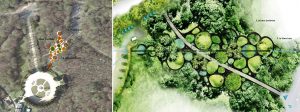
Further development of landscape designs for “The Third Train” project.
Images © Gilles Brusset – Paysarchitectures.
A component of conventional landscape designs which rarely appears in cemetery and mass grave projects is water (creeks or rivers, ponds or lakes), but there will be exceptions.
Designs follow formal or informal rules of composition to create and evolve the forms with attention to a visual hierarchy, arranging components to make some more dominant than others according to the design concepts. Designs may be conceived and described in terms which emphasize geometry (e.g. grids, axes, radial or orthogonal, symmetric or asymmetric, etc.) or terms which emphasize organic bodily structures of plants or animals (e.g. trunk, branch, and node, or head, spine, arm, artery, etc.). These structural approaches to composition highlight how existing and new hardscape features can influence both the organization of a site by the designer and an appreciation of the final landscape by a visitor.
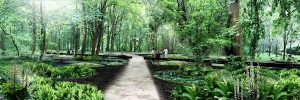
Walk-through visualization of the maturing landscape design for “The Third Train” project.
Image © Gilles Brusset – Paysarchitectures.
Methods for defining spaces at the site using the components listed above can be seen in the examples on this page and in visual collections of realized memorial site projects (see the landscape references page). Individual project preferences and the guiding concepts will determine how structure, space, scale, forms, geometry, textures, colors, and human interaction with the site (behavior and response) influence the final design.
Professional landscape design firms exist in each of the oblasts of western Ukraine, as well as abroad, which may be able to support projects where the landscape issues are substantial or the project leaders lack the needed skills. Some suggested design resources are listed on the experts page on this website, but others can be found through ordinary internet searches, and municipal authorities in larger towns and cities may also be able to recommend local design and installation resources.
Remedial Landscaping and Design for Sustainability
For many Jewish cemetery and mass grave sites in western Ukraine, control of the landscape – to slow or stop the growth of wild vegetation, or to reduce erosion and subsidence of soil – is the priority objective of the preservation project. Typically a new project at an untended site begins with assessment followed by tasks to identify and mark the site (signage and fencing) and to promote the site as worthy of respect and remembrance (vegetation clearing and the erection or repair of monuments). After these significant steps, however, the issue of maintenance and sustainability should become primary, or the investment of effort and money will disappear within a decade under renewed plant and tree growth and other natural forces of decay.
Before any landscaping plan is developed, soil stability issues revealed by the site survey should be addressed, through retaining walls, terracing, or other methods. This is a specialized field of work; treatments should be specified by engineers and reviewed by regional rabbinical authorities to prevent serious long-term harm. Similarly, if the survey identifies trees or other major plantings or wild growth showing disease or serious damage, these issues should be resolved before or during the landscape planning process. The references page includes text and video guidance for several types of basic preparation work, including installation of french drains, tree pruning or felling, and more.
Western Ukraine is not unique in Europe to be favored with climate and soils which promote rapid growth of plants, but the region has been well known (and desired) for centuries for its agricultural productivity by peoples to both the east and the west. This green fecundity also produces strong growth of less desirable plants and trees, of course; “weeds” in and around Jewish burial sites are merely plants which grow in unwanted places, or which are noxious to humans.

Three styles and colors of chipped bark mulch used to suppress wild vegetation in designed landscapes. Photos © RJH.
A simple but somewhat labor-intensive approach to remedial landscaping for retarding or blocking the growth of unwanted vegetation is to replace the top layer of mixed wild grasses and shrubs with an inert or living barrier layer. There are many different means to create a vegetation barrier in selected spaces within or around a burial site (e.g. walking paths, mass grave boundaries, around signs and monuments, or larger areas); some common ones are:
-

Three styles and colors of crushed rock used to suppress wild vegetation in designed landscapes. Photos © RJH.
installation of a water-permeable landscape fabric, followed by a layer of:
- crushed rock or gravel
- chipped or shredded and chemically-treated bark mulch
- other inert loose material
- paving bricks or stones
- seeding with a low-growing, dense-root grass
- planting low-growing and fast-spreading ground-cover plants
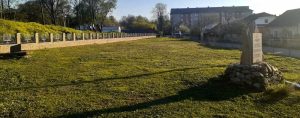
Land at the front of the Jewish cemetery in Nadvirna (Ivano-Frankivsk oblast) reclaimed, scraped and cleared of vegetation, and seeded with dense grass by ESJF to control new growth. Photo © ESJF.
Landscaping guidance for each of these methods generally recommends removing or killing the original top layer of growth before installing the barrier replacement. This can mean scraping a thin layer of plants and soils, and/or selectively or broadly using herbicides, with a waiting period to ensure that the treatment was effective, especially before new seeding. A layer of loose inert materials will normally require edging bands at the perimeter to minimize the migration of materials across boundaries; many types of edging are available for this common need. Taller edging or low masonry or timber walls may be needed to contain fast-spreading ground-cover plants and to minimize the need for routine trimming of these plants at boundaries (especially when there are residential yards neighboring the cemetery).

Periwinkle carpets the ground of a tree-covered cemetery in the village of Małastów in southeastern Poland. Photo © RJH.
When selecting inert materials for ground cover purposes, in addition appearance factors (color and texture) and cost, research should also evaluate the likely future availability of the material in the local area, so that the spaces can be compatibly renewed and refilled after settling and decay. Ground cover grasses and other plants should be chosen from among regional native species if at all possible, both for cost and hardiness reasons; otherwise non-invasive plants compatible with the local soils and climate should be identified by knowledgeable experts in the region.
Many people have observed that mature trees in cemeteries and overlooking mass graves in forests often naturally retard wild growth at the ground level by blocking or filtering sunlight at their canopies during the growing seasons. This effect can be exploited and enhanced in landscaping these sites by planting or encouraging the growth of shade-loving, non-climbing ground-cover plants traditionally found at tree-filled burial sites, such as periwinkle (especially Vinca minor), a plant which spreads via clonal colonies and thrives in western Ukrainian forests; cuttings from forests can be transplanted to cemetery sites at very low cost.
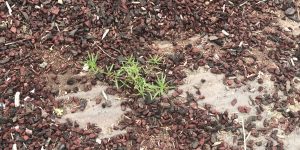
Failure of landscape fabric due to insufficient mulch coverage allows weeds to penetrate. Photo © RJH.
Remedial landscape treatments to suppress or stop the growth of wild vegetation are not complete and “permanent” solutions, even those which install inorganic materials such as stone and brick. The landscaping approaches which incorporate living materials need time and local attention (water, soil amendments, spot weeding or herbicides) before they become established and can sustain themselves through all four seasons. Both inert and living layers require occasional renewal and cleaning after a few years, and all treatments will eventually require more significant maintenance or replacement. In most cases, however, the project is worth the effort and cost: the investment of materials and labor to install and maintain the treated areas will lead to substantially fewer and less intense wild vegetation cutting and clearing efforts, and a more stable and orderly appearance to the site.
Landscape Design for Reflection and Commemoration

Piet Oudolf’s realized plan for the Gardens of Remembrance at Battery Park in New York City.
Photos © Allan Pollock Morris.
The references page for landscape planning and development includes texts and articles which provide guidance and examples of designs ranging widely from the elaborately styled to “doing almost nothing”. Despite the significant differences in strategies, each of these resources aims to aid in revealing and communicating the meaning of the site. For Jewish cemeteries and mass graves, intentionally aesthetic designs seek to promote commemoration of the lost Jewish community buried there and in some cases reflection on the events of the Holocaust at or near the place. Alternatively, some landscape concepts acknowledge the sharp break in history caused by the Holocaust, and the postwar absence of a Jewish community to care for the place, so prefer to work toward a controlled or “curated” decay of the heritage site instead of conventional (and perhaps impossible) preservation.

Oudolf’s seasonally-varying plantings at Maximilianpark in Germany. Photos © Brüse.
Resources for the development of project concepts include several texts and articles which can inform designs to enable the interpretation of sites of memory and guide human behavior and response at these sites. Landscaping design for memorial purposes is especially well-suited to Jewish mass graves in western Ukraine, as otherwise these bleak places acknowledge nothing of the history and horror of the sites. Landscaping at sites can shape and enhance the experience of visitors even with relatively simple features such as paths to facilitate access and suggest viewing points.
The breadth of possible concepts and designs for commemorative and reflective landscapes at burial sites is too extensive to summarize on this page. Theoretical guidance and practical examples are given in the resources linked above. For inspiration and suggestion for the design and development of this type of landscape, several completed projects mostly from outside western Ukraine are shown here and in the next section.

Three memorial landscapes with monuments at Jewish mass graves near Šeduva, Lithuania. Photos © RJH.
Additional Examples of Designed Memorial Site Landscapes
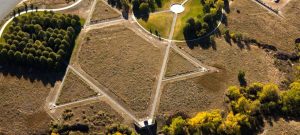
An aerial view of the Babi Yar Memorial Park in Denver. Image © Mizel Museum.
Several pictorial examples of completed commemorative landscape projects from a few of the resources linked to the landscape resources page on this website are shown here for reference and consideration. In some cases these projects were designed and developed for cemeteries, though few are for Jewish sites. Others are intentional memorial landscapes, sometimes with monuments, but not specifically located at burial sites or killing sites. Still others commemorate the Holocaust in Europe and some remind of killings at specific locations, but are located far from those sites of tragedy for the benefit of survivors, descendants, and others in foreign lands. Each of these memorial landscapes offers conceptual and practical approaches worth considering in new landscape projects at Jewish burial sites in western Ukraine.
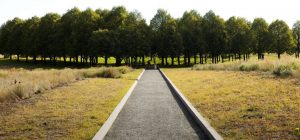
The symbolic grove at the Babi Yar Memorial Park in Denver. Image © Mizel Museum.
The Cultural Landscape Foundation (TCLF) is a non-profit organization which promotes shared landscape heritage through several programs including a large database of cultural landscapes, primarily in the United States. A significant section of their database collects summaries and images of over 100 documented commemorative landscape projects of many types. Browsing the database series can spark ideas for new projects, or provide alternatives for comparison and contrast to initial concepts. Examples which may translate well to projects in western Ukraine include the Garden of Righteous Gentiles in Wilmington, Delaware, and the Babi Yar Memorial Park designed as a living memorial for the Mizel Museum in Denver, Colorado. Several sites of the American Civil War demonstrate how shaping and curating landscapes with few or no visible remains of historical events can enhance the commemorative function of these places, including three memorial landscapes in Virginia: the Cold Harbor Battlefield and the Totopotomoy Creek Battlefield in Mechanicsville, plus Fort Harrison near Richmond. A few images from each of these projects are shown here but many more are available (and searchable) on the TCLF website.

Landscape design elements of the Babi Yar Memorial Park in Denver: the plaza which unites the space, and a bridge over a symbolic ravine representing the killing and burial site. Images © Mazil Museum.

Views of the Garden of the Righteous Gentiles in Delaware. Source: TCLF.

Three memorial sites of the American Civil War in Virginia: Cold Harbor Battlefield, Totopotomoy Creek Battlefield, Fort Harrison. Images © TCLF.
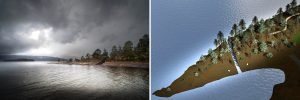
A dramatically landscaped memorial site on Utøya island in Norway. Images © Jonas Dahlberg Studio via Landezine.
Frequently ranked the most-visited landscape architecture website during the past decade, Landezine is a heavily-illustrated magazine-format platform created by landscape architects for landscape architects, which makes it very useful for others who wish to “look over the shoulder” of top professionals to see how they work and what they produce. Based in Slovenia but monitoring new work around the world, the site features a project database sorted by place type, design features, and intended landscape use. In the category of cemeteries and memorial sites, Landezine illustrates more than 40 completed landscape projects ranging from minimal adjustments to existing cemetery layout, spaces, and structures, to large-scale gardens and glades of peace at former sites of conflict in both forests and urban settings. While the site documents important projects commemorating Jewish history and the Holocaust (such as the Memorial to the Murdered Jews of Europe, in Berlin), striking smaller-scale memorials at other sites unrelated to Jewish history may provide more useful conceptual stimulation for projects in western Ukraine. For example, the Memorial to Victims of Violence in Mexico transforms an open space through the use of high vertical elements (trees and steel structures) with unusual interactive wall spaces in Mexico City; near Oslo in Norway, the victims of a massacre on the island of Utøya in 2011 were commemorated with several forms of landscape architecture, including severing the tip of the island where many of the deaths occurred from the main landform; and sites of memory of World War I in the northernmost region of France which include a forest undergrowth garden of “The Third Train”, a symbolic wooden rail which follows wartime trench lines and the mycelium network through allées and rounded planted spaces to contrast destruction and regrowth, and to connect people to the forest where the war raged. Other Landezine website features include profiles of landscape architecture firms and interviews with key designers, reviews of manufacturers and products (e.g. for hardscaping and benches), and surveys of award-winning designs around the world.

The Memorial to Victims of Violence in Mexico. Images © Sandra Pereznieto via Landezine.

“The Third Train” WWI memorial forest gardens in northern France. Images © Pierre-Yves Brunaud via Landezine.
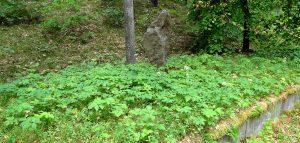
Part of the memorial complex in the Biķernieki Forest near Riga, Latvia. Source: Adam Jones.
The Center for Judaic Studies at the University of Latvia manages a database project on Holocaust Memorial Places in Latvia which maps, describes, and illustrates the known memorial sites of killing and burial of Jews in Latvia during the German occupation of World War II. The project is supported by the International Holocaust Remembrance Alliance, the Council of Jewish Communities of Latvia, the museum “Jews in Latvia”, and the Dutch Jewish Humanitarian Fund. The Holocaust in Latvia was intense as it was in western Ukraine; the project documents about 150 memorial places in the country with summary sourced histories and images of the sites including memorial landscaping, monuments, signs etc., though generally only a small number of photos are available of each site. For further study, Wikimedia Commons has larger collections of photos of some of these sites. Only two examples are shown here, both from forest killing sites near Latvia’s capital of Riga: the huge murder and burial site of Rumbula, and the largest Jewish mass grave in Latvia in the Biķernieki Forest. Both sites feature memorial landscapes and monument ensembles designed by the architect Sergey Rizh and installed in 2000-2002. Many more examples are included in the full database.

Panorama of the memorial complex in the Rumbula Forest near Riga, Latvia. Source: Adam Jones.

Panorama of the memorial complex in the Biķernieki Forest near Riga, Latvia. Source: Adam Jones.

Panorama of the memorial complex in the Biķernieki Forest near Riga, Latvia. Source: Adam Jones.

